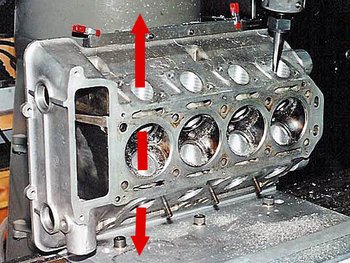Difference between revisions of "Crossflow cylinder head"
m |
m |
||
| Line 1: | Line 1: | ||
| − | [[Image:Alfa-Head-Porting.jpg|thumb|right|350px|<center>Alfa Romeo cylinder head being ported and red arrow showing the very efficient straight through air passage way</center>]] | + | [[Image:Alfa-Head-Porting.jpg|thumb|right|350px|'''<center>Alfa Romeo cylinder head being ported and red arrow showing the very efficient straight through air passage way</center>''']] |
A '''crossflow cylinder head''' is a [[cylinder head]] that features the [[intake manifold|intake]] and [[exhaust manifold|exhaust]] ports on opposite sides. The gases can be thought to flow across the head. This is in contrast to cylinder head designs that have the ports on the same side. | A '''crossflow cylinder head''' is a [[cylinder head]] that features the [[intake manifold|intake]] and [[exhaust manifold|exhaust]] ports on opposite sides. The gases can be thought to flow across the head. This is in contrast to cylinder head designs that have the ports on the same side. | ||
Revision as of 09:48, 1 July 2007
A crossflow cylinder head is a cylinder head that features the intake and exhaust ports on opposite sides. The gases can be thought to flow across the head. This is in contrast to cylinder head designs that have the ports on the same side.
A crossflow head gives better performance, but the popular explanation put forward for this — that the gases don't have to change direction and hence are moved into and out of the cylinder more efficiently — is largely erroneous since there is no continuous flow because of opening and closing of the valves. The main reason for a crossflow's performance is that the ports and valves can be larger and its physical separation of the hot exhaust manifold keeps the air in the intake manifold cooler. Most modern engines are of a crossflow design.
One of the most successful crossflow engines is the Alfa Romeo 4-cylinder. Used for decades, the basic design of this engine had not changed; only the capacity/liter size and with the changes in fuel delivery (from carburetors, mechanical fuel injection and then to electronic fuel injection).
"Crossflow" is often used to refer specifically to Ford's Kent Crossflow 4-cylinder OHV engine. This unit has been used in cars from the 1960s up to the present day, albeit with the addition of fuel injection and modern engine management.
